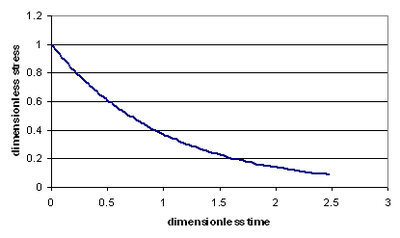- Maxwell material
-
A Maxwell material is a viscoelastic material having the properties both of elasticity and viscosity. It is named for James Clerk Maxwell who proposed the model in 1867. It is also known as a Maxwell fluid.
Contents
Definition
The Maxwell model can be represented by a purely viscous damper and a purely elastic spring connected in series, as shown in the diagram. In this configuration, under an applied axial stress, the total stress, σTotal and the total strain,
 can be defined as follows:
can be defined as follows:- σTotal = σD = σS

where the subscript D indicates the stress/strain in the damper and the subscript S indicates the stress/strain in the spring. Taking the derivative of strain with respect to time, we obtain:
where E is the elastic modulus and η is the material coefficient of viscosity. This model describes the damper as a Newtonian fluid and models the spring with Hooke's law.
If we connect these two elements in parallel, we get a model of Kelvin-Voigt material.
In a Maxwell material, stress σ, strain ε and their rates of change with respect to time t are governed by equations of the form:
or, in dot notation:
The equation can be applied either to the shear stress or to the uniform tension in a material. In the former case, the viscosity corresponds to that for a Newtonian fluid. In the latter case, it has a slightly different meaning relating stress and rate of strain.
The model is usually applied to the case of small deformations. For the large deformations we should include some geometrical non-linearity. For the simplest way of generalizing the Maxwell model, refer to the Upper Convected Maxwell Model.
Effect of a sudden deformation
If a Maxwell material is suddenly deformed and held to a strain of
 , then the stress decays with a characteristic time of
, then the stress decays with a characteristic time of  .
.The picture shows dependence of dimensionless stress
 upon dimensionless time
upon dimensionless time  :
:If we free the material at time t1, then the elastic element will spring back by the value of
Since the viscous element would not return to its original length, the irreversible component of deformation can be simplified to the expression below:
Effect of a sudden stress
If a Maxwell material is suddenly subjected to a stress σ0, then the elastic element would suddenly deform and the viscous element would deform with a constant rate:
If at some time t1 we would release the material, then the deformation of the elastic element would be the spring-back deformation and the deformation of the viscous element would not change:
The Maxwell Model does not exhibit creep since it models strain as linear function of time.
If a small stress is applied for a sufficiently long time, then the irreversible stresses become large. Thus, Maxwell material is a type of liquid.
Dynamic modulus
The complex dynamic modulus of a Maxwell material would be:
Thus, the components of the dynamic modulus are :
and
The picture shows relaxational spectrum for Maxwell material. The relaxation time constant is
 .
.Blue curve dimensionless elastic modulus 
Pink curve dimensionless modulus of losses 
Yellow curve dimensionless apparent viscosity 
X-axis dimensionless frequency ωλ. References
See also
- Generalized Maxwell material
- Kelvin-Voigt material
- Oldroyd material
- Standard Linear Solid Material
- Upper Convected Maxwell model
Categories:- Non-Newtonian fluids
- Materials science
- James Clerk Maxwell
Wikimedia Foundation. 2010.














